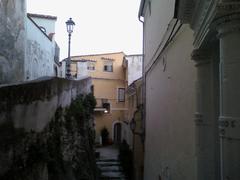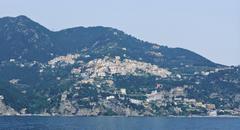Benincasa Vietri sul Mare Visiting Hours, Tickets, and Travel Guide
Date: 03/07/2025
Introduction
Benincasa, perched gracefully on the hills above Italy’s Amalfi Coast, is a peaceful hamlet within the municipality of Vietri sul Mare. Rich in medieval history, culture, and natural beauty, Benincasa offers an authentic experience far removed from the bustling tourist hubs. Characterized by its labyrinthine alleys, historic buildings, artisanal traditions, and a tranquil atmosphere, the village is a must-visit for travelers seeking the true spirit of Campania (Portale Ospitalità Vietri, Wikipedia, Travel Amalfi Coast).
Table of Contents
- Origins and Historical Development
- Economic and Social Traditions
- Religious and Architectural Heritage
- Visiting Information: Hours, Tickets, and Accessibility
- Guided Tours and Events
- Artistic and Ceramic Traditions
- Natural Attractions and Walking Trails
- Practical Tips: Getting There, Accommodation, and Dining
- Local Festivals and Community Life
- Frequently Asked Questions (FAQ)
- Conclusion and Visitor Tips
- References
Origins and Historical Development
Benincasa’s origins trace back to the early 12th century, emerging as a rural community seeking fertile land and safety above the coast. The village’s medieval roots are evident in its compact urban structure, with densely clustered houses, narrow alleys, and steep stairways—typical of hill settlements designed for both defense and efficient land use (Portale Ospitalità Vietri). Historically, Benincasa was less prominent in early records compared to neighboring villages, but its growth paralleled the region’s agricultural and maritime expansion.
Economic and Social Traditions
Benincasa’s social identity is intertwined with its economic history. The villagers, known as “Saracani,” were traditionally involved in the curing and trade of salted fish, especially “salacche” (salted sardines and anchovies). This trade not only supported the local economy but also linked Benincasa to broader Mediterranean networks. The preservation of fish was vital for food security and commerce, giving the hamlet a unique niche among Amalfi Coast communities (Portale Ospitalità Vietri).
Religious and Architectural Heritage
Church of Santa Maria delle Grazie
The heart of Benincasa’s religious and architectural life is the Church of Santa Maria delle Grazie. With bell inscriptions dating to 1610 and documentation from 1697, the church is a testament to the village’s deep spiritual roots. By 1717, it gained baptistery status, marking Benincasa’s ecclesiastical independence. Inside, visitors can admire:
- A marble high altar with a remarkable 1737 bas-relief depicting the Visitation, created by Giuseppe Benincasa and collaborators.
- A 16th-century wooden baptismal font cover.
- Artistic works in local polychrome ceramics.
The church remains central to community events, religious festivals, and daily life (Wikipedia, Chiesa Benincasa).
Visiting Information: Hours, Tickets, and Accessibility
- Church of Santa Maria delle Grazie: Open daily from 9:00 AM to 12:00 PM and 4:00 PM to 7:00 PM. Admission is free; donations are appreciated.
- Provincial Ceramic Museum (Villa Guariglia, Raito): Tuesday–Sunday, 10:00 AM to 6:00 PM. Tickets: €5 adults, €3 students/seniors, free for children under 12.
- Solimene Ceramic Factory: Visits by appointment only.
Benincasa’s streets are steep and cobbled; visitors with mobility challenges should plan ahead. The church has ramp access, but general accessibility is limited (Portale Ceramica Vietri).
Guided Tours and Events
Local operators and the parish offer guided tours highlighting Benincasa’s history, religious sites, and ceramics traditions. Religious festivals, especially the feast of Santa Maria delle Grazie in July, feature processions, music, and communal meals (Chiesa Benincasa). For ceramic workshops and artisan demonstrations, inquire with the Vietri sul Mare tourist office or local studios.
Artistic and Ceramic Traditions
Benincasa is part of the renowned Vietri ceramics district. While the ceramics hub is in Vietri sul Mare, Benincasa’s artisans contribute to the region’s vibrant tradition. Decorative ceramics adorn public spaces, shrines, and churches throughout the hamlet.
Museo della Ceramica Vietrense in Raito displays centuries of ceramic art, including pieces from Benincasa. Participatory ceramic workshops offer visitors a chance to create their own pottery using time-honored techniques (Amalfeet).
Natural Attractions and Walking Trails
Benincasa’s location offers panoramic views over the Tyrrhenian Sea and the Gulf of Salerno. Scenic footpaths wind through lemon groves, olive orchards, and terraced gardens, connecting Benincasa with Dragonea, Raito, and Albori. The routes are ideal for photography, especially at sunrise or sunset (Portale Ceramica Vietri).
Nearby beaches, such as La Baia and Marina di Albori, are easily reached by car or bus from Benincasa (Italy Travel Secrets).
Practical Tips: Getting There, Accommodation, and Dining
Getting There
- By Air: Naples International Airport is the closest, about 60 km away. From there, take a train or car to Salerno, then local transport to Vietri sul Mare and Benincasa.
- By Train: Salerno is the nearest major station. From Salerno, take a local train or bus to Vietri sul Mare, then a local bus or taxi to Benincasa (The Road Reel).
- By Car: Exit the A3 motorway at Vietri sul Mare. Parking is limited; use designated lots.
- By Bus: SITA Sud buses connect Salerno, Vietri sul Mare, and Benincasa. Confirm schedules in advance (Tour Italy Now).
Accommodation
Benincasa features family-run B&Bs, holiday rentals, and agriturismi. For more options, stay in Vietri sul Mare and visit Benincasa by day (The Road Reel).
Dining
Local trattorias serve Campanian specialties—seafood pasta, anchovy colatura, and lemon desserts (“delizia al limone”). Many eateries offer terraces with sweeping coastal views (Italy Travel Secrets).
Local Festivals and Community Life
Benincasa’s religious and cultural calendar is anchored by the feast of Santa Maria delle Grazie, with processions, music, and communal feasting. The area also celebrates ceramics and cuisine during events at Villa Guariglia in Raito (Travel Amalfi Coast). These traditions foster a strong sense of community and offer visitors immersive cultural experiences.
Frequently Asked Questions (FAQ)
Q: How do I reach Benincasa from Vietri sul Mare?
A: Use local buses, taxis, or enjoy a scenic walk along hillside paths.
Q: When is the church open to visitors?
A: Generally, daily from 9:00 AM–12:00 PM and 4:00 PM–7:00 PM; check locally for festival variations.
Q: Are guided tours available?
A: Yes, through local operators and the parish. Ceramic workshops and artisan tours can also be arranged.
Q: Is Benincasa accessible for those with mobility issues?
A: The terrain is steep and cobbled; accessibility is limited.
Q: What is the best time to visit?
A: Spring (April–June) and early autumn (September–October) offer mild weather and fewer crowds.
Conclusion and Visitor Tips
Benincasa rewards visitors with its tranquil ambiance, medieval charm, and layered history. Its integration with Vietri sul Mare’s ceramics tradition, scenic trails, and religious heritage create a unique destination for cultural travelers. Plan your trip during spring or autumn, take part in local festivals, and support artisan businesses to fully appreciate Benincasa’s enduring allure.
For real-time updates, event listings, and interactive maps, download the Audiala app or consult the official Vietri sul Mare tourism website.
References
- Portale Ospitalità Vietri
- Wikipedia
- Amalfi Coast Day Tours
- Travel Amalfi Coast
- UNESCO Amalfi Coast
- Amalfeet
- Chiesa Benincasa
- Portale Ceramica Vietri
- Italy Travel Secrets
- The Road Reel
- Tour Italy Now
- Praianonline
- Life in Italy
- Authentic Amalfi Coast
- Maddy’s Avenue
- Italoamericano



